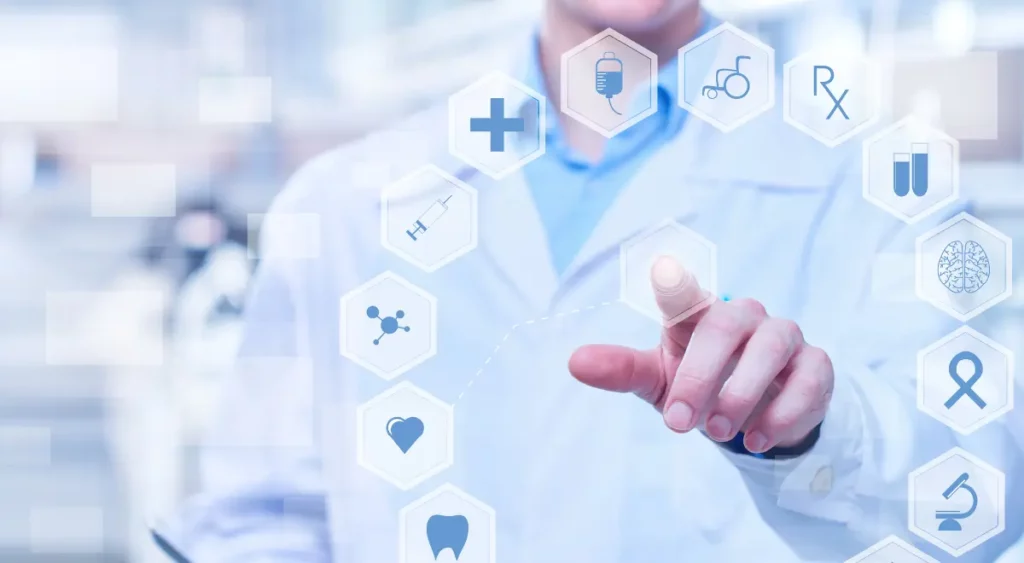How Cybersecurity Threats Are Shaping the Future of RPM Systems?

As advancements in healthcare technology accelerate, so do the risks of cybersecurity vulnerabilities. Remote Patient Monitoring (RPM) systems are frequently exposed to cybersecurity risks. With an increasing frequency of cyber threats, healthcare software providers must employ proven strategies to safeguard sensitive patient data and ensure the integrity of their healthcare system.
In this blog we’ll dive deep into the relationship between cybersecurity threats and the future of RPM systems.
Table of Contents
ToggleThe Interconnection Between RPM Systems & Cybersecurity Threats
Remote patient monitoring systems allow healthcare providers to monitor their patients remotely and track their health data in real-time. These systems make use of FDA-approved remote monitoring devices for reporting patient’s vitals and health metrics directly to the concerned healthcare provider via an RPM platform. This facilitates timely decision-making and interventions, thereby improving patient outcomes.
With the rising popularity of RPM technologies, the risks associated with cyber threats also rise. Some of the most common cybersecurity threats include:
- Data Breaches: Data breaches refer to the unwanted access of patient data. These unauthorized breaches lead to patient identity thefts and privacy violations.
- Ransomware: Ransomware encrypts healthcare data and demands a ransom to restore access, posing a significant risk to patient information.
- Denial of Service (DoS) Attacks: This type of cybersecurity concern attacks the operational capability of the RPM systems by denying access to both patients and healthcare providers.
- Phishing Attacks: These attacks involve sending fraudulent emails and threats to trick the healthcare staff in providing access to the RPM system.
- IoT Vulnerabilities: Internet of Things (IoT) vulnerabilities refers to threats within RPM systems where RPM devices are connected to the unsecured internet, which exposes the system to hackers.
Regulatory Frameworks and Compliance for Cybersecurity
Wherever there are cyber risks, there are regulatory frameworks designed and formulated to govern patient data protection protocols. The Health Insurance Portability and Accountability Act (HIPAA) establish the standards for safeguarding sensitive patient information for healthcare systems. All medical practices and healthcare organizations must comply with HIPAA guidelines to avoid penalties and legal actions.
Other than HIPAA, Service Organization Control Type 2 (SOC 2) and National Institute of Standards and Technology’s (NIST) Cybersecurity Framework also needs to be complied with. It provides guidance on risk assessment, incident response, and overall security compliance.
Advanced Security Technologies to Mitigate Cybersecurity Risks
With the growing rate of cybersecurity risks, healthcare providers are relying on advanced security technologies and tools to avoid underlying RPM system security threats. Some of the most effective technologies that can help safeguard against risks and threats include:
- Data Encryption: Data encryption refers to making data unreadable to unauthorized parties. This is done by encrypting a message or figures into symbolic letters. This is done for data both at rest and in transit. This data can only be analyzed by a healthcare provider having access to a decryption key.
- Multi-Factor Authentication (MFA): Multi-factor means using two or more ways of authenticating the identity of a user. MFA adds an additional layer of security on the RPM system.
- Intrusion Detection Systems (IDS): With malicious phishing attacks and cybersecurity concerns rising on the over-the-cloud healthcare platforms, IDS plays a crucial role. It works by addressing the patient data and privacy security concerns by monitoring the network traffic, flagging the suspicious activity, and responding to potential threats in real-time, thereby allowing healthcare providers to address potential security threats before they can cause harm.
- Artificial Intelligence (AI) and Machine Learning (ML): These system driven tools can analyze patterns that may indicate a cyber threat and automatically enables proactive security measures by detecting suspicious activities in real-time and initiating immediate security responses.
Future Trends in RPM Systems and Cybersecurity
As the RPM landscape evolves, several key trends are shaping the future of cybersecurity within healthcare systems. Cybersecurity will continue to be a challenge for RPM systems. With the evolving RPM technology, several key trends are shaping the future of cybersecurity within healthcare systems.
Some of these trends include:
- Increased Adoption of Cloud Services: Over the cloud platforms operate using cloud computing and provide the much needed scalability and flexibility to healthcare organizations that are planning to expand their services in the future. Before choosing a cloud service provider, healthcare organizations must carefully analyze their scope of services, security protocols, and security features to ensure robust protection.
- Focus on Interoperability: Most healthcare providers use Electronic Health Records (EHRs) and RPMs in integration. Though it offers interoperability features for seamless sharing and exchange of patient data between EHRs and RPM platforms, secure data sharing may pose challenges. Make sure standardized security procedures are being followed for enhanced security.
- Regulatory Evolution: With the continuous evolvement of cybersecurity threats, maintaining compliance with the latest regulatory frameworks is a must. To effectively protect patient data, healthcare organizations must remain flexible and open to new compliance measures.
- Enhanced User Experience with Security: To adhere to the cyber safety protocols in the future, RPM systems must prioritize user experience as well as security measures. This balance between ease of use and strong security adherence will be essential to ensuring both patient and provider satisfaction with RPM systems.
Boost Your RPM System Security With HealthArc
Cybersecurity issues are greatly influencing the future of remote patient monitoring systems. Healthcare providers must go through the ins and outs of RPM and cybersecurity to choose a system that not only complies with security protocols but also improves patient care and satisfaction.
HealthArc’s all-in-one advanced care management platform helps practices in connecting to their patients in a remote setting, without compromising their privacy and data security. Being HIPAA compliant, we promise unmatched data security and privacy, along with adherence to CMS guidelines and policies.
To find out how our digital health platform can help you adhere to RPM security protocols while maintaining security mechanisms, schedule a free demo or give us a call at (201) 885 5571.
Frequently Asked Questions (FAQs)
In cyber security, RPM (Remote Patient Monitoring) means keeping medical IoT devices, data transmission, and cloud platforms used for patient monitoring safe. Because RPM involves sharing sensitive health data all the time, it is a prime target for hackers. This is why encryption, secure networks, and compliance frameworks are so important.
An RPM system uses secure software to collect and send patient health data (like blood pressure or glucose levels) to providers. It does this by combining wearable or home-based medical devices. It cuts down on in-person visits, lets you monitor patients in real time, and helps with managing chronic care, but it needs strong cyber security to protect patient data.
The main thing that telehealth is about is virtual consultations (video or phone calls) between patients and doctors. RPM goes a step further by collecting patient vitals from connected devices all the time, storing the data, and letting providers know if there are any problems. They work together to improve care, but they each have their own jobs.
Common threats include ransomware attacks on healthcare networks, phishing schemes that target provider logins, Distributed Denial of Service (DDoS) attacks that disrupt device connectivity and malware that targets IoT medical devices. All of these can slow down care and put patient information at risk.
- Encryption is used to protect data that is moving and data that is not moving.
- Multi-factor authentication (MFA) is used to stop unauthorized logins.
- Intrusion detection systems (IDS) are used to flag unusual activity.
- AI-powered monitoring looks for suspicious behavior across networks and devices.
AI makes it faster to identify and address cyber threats. It can find strange patterns, like data flows that aren’t normal, and guess where there might be weaknesses before they are used. It can also automate responses faster than people can. AI is very important for improving security in RPM systems.
In the U.S., HIPAA protects patient privacy and data security. SOC 2 provides guidelines for how to handle sensitive information, and the NIST Cybersecurity Framework lays out structured controls. To avoid fines and make sure they are following the rules, providers who use RPM must follow these frameworks.
If you don’t obey the rules, you could face fines of $100 to $50,000 for each violation, class-action lawsuits, and damage to your reputation, and even penalties from CMS for not getting paid. This risk is even higher for RPM programs because there is always data flowing between patients and providers.
Interoperability between EHRs and RPM platforms improves patient outcomes, but it also makes the attack surface bigger. Health records can be improperly accessed if APIs are poorly protected, integration practices are weak, or standards are inconsistently followed.
- Using HL7/FHIR standards
- Setting up API gateways with secure authentication
- Encrypting all data transfers
- Doing regular penetration testing
These are all ways to assure that data moves safely between RPM platforms and EHR systems.
Cloud-native platforms with built-in security will be used more often in the future, as will zero-trust architectures, AI-driven anomaly detection, and compliance frameworks that are constantly changing. These trends are changing the way that RPM providers get ready for long-term security problems.
- Bluetooth-enabled blood pressure cuffs
- Continuous glucose monitors
- Pulse oximeters
- ECG patches
- Smart weight scales
- Spirometers
To stop hackers from getting into health data and changing or stealing it, each device must be locked down.
Keeping HIPAA-level security, buying advanced cyber security tools, and protecting IoT medical devices can all add a lot to the cost of running a business. But the cost of a breach, both in terms of money and reputation, is usually much higher.
Cloud solutions offer ease of integration, business growth potential, and remote access. However, incorrect setup and inadequate security monitoring could lead to data leaks. Providers need to carefully check that cloud vendors follow HIPAA rules and have good systems for managing identities.
HealthArc makes sure it follows HIPAA rules by using end-to-end encryption, multi-factor authentication, and access controls based on roles. Its platform also lets providers change the security settings to fit with their IT and compliance rules, making sure that the platform is both safe and easy to use.
Bibliography
- FDA Guidance on Cybersecurity for Medical Devices
- FDA – Cybersecurity for Medical Devices
- Understanding Remote Patient Monitoring (RPM)
- A Framework for Cybersecurity in Healthcare
Most Recent Blogs
Categories
Related Blog
- October 23, 2025 | Read Time: 12 mins
How RPM Devices Improve Hypertension and Diabetes Outcomes in Medicare Populations
Remote patient monitoring (RPM) is transforming chronic care for Medicare beneficiaries. CMS...
Learn More- August 25, 2025 | Read Time: 13 mins
How Can “One Big Beautiful Bill” Boost RPM Programs by $50B?
The “One Big Beautiful Bill,” signed July 4, 2025, directs $50B over...
Learn More- August 22, 2025 | Read Time: 17 mins
HealthArc Platform vs RPM Software Solutions
Is your healthcare organization trying to pick a remote patient monitoring solution?...
Learn More


